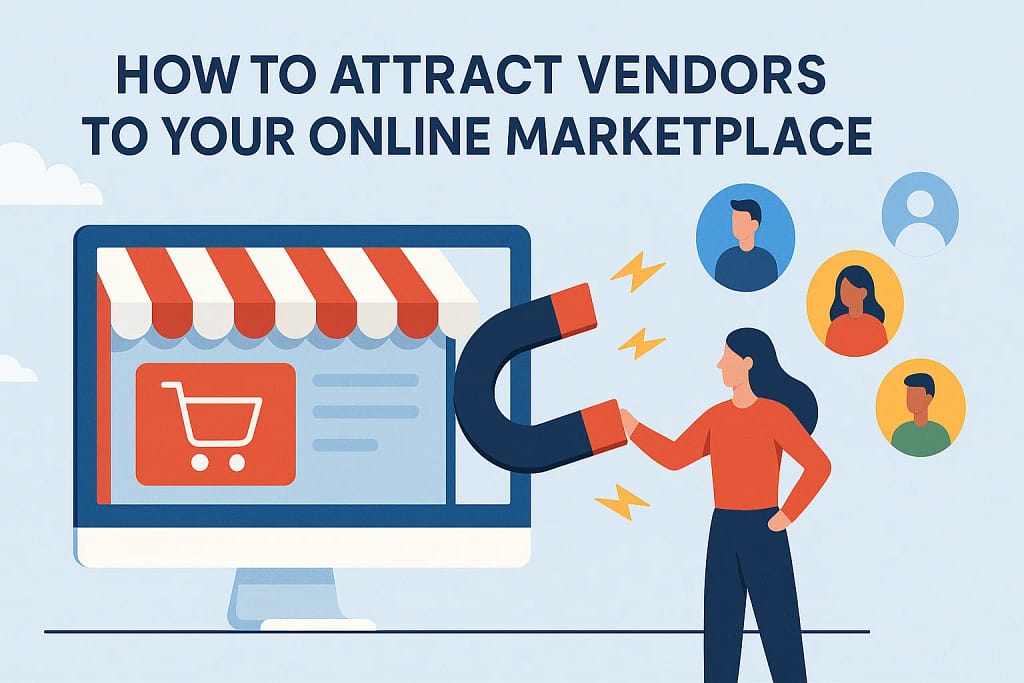In today’s digital-first economy, building an online marketplace is one of the most scalable and profitable eCommerce models. From giants like Amazon and Etsy to niche platforms for handmade goods or specialty foods, online marketplaces rely heavily on one key ingredient: vendors. Without quality sellers providing products and services, even the most beautifully designed marketplace won’t thrive.
But attracting vendors—especially in the early stages—is no easy feat. If you want to build a successful multivendor platform, you’ll need a strategy to not only bring vendors in but also keep them engaged and satisfied.
In this article, we’ll explore proven strategies for attracting vendors to your online marketplace, whether you’re just launching or trying to scale.
Why Vendors Are Crucial to Your Online Marketplace
The core value proposition of an online marketplace is variety and availability. Vendors bring that to life by listing products, managing inventory, and servicing customers. The more vendors your platform has, the broader the selection you offer, and the more likely you are to meet customer expectations.
Additionally, third-party sellers often bring their own customer base. If they market their listings effectively, they drive traffic back to your platform. It creates a positive feedback loop: more vendors attract more buyers, and more buyers attract more vendors.
So, how do you bring those first 10, 100, or 1,000 vendors to your marketplace? Let’s break it down.
1. Define Your Ideal Vendor Profile
Before you start vendor acquisition, you must understand who your ideal vendors are. Are you targeting independent artists? Local retailers? Wholesale distributors?
Create a vendor persona based on factors such as:
Product category
Business size (individual sellers vs. large-scale merchants)
Geographic focus (local, national, international)
Pricing strategy and branding
Inventory capabilities
This clarity helps you craft messaging, features, and incentives that truly resonate with the right vendor audience.
2. Simplify the Vendor Onboarding Process
First impressions matter. If your vendor onboarding process is clunky, complex, or unclear, potential sellers will abandon ship before even listing a product.
Make sure your eCommerce platform offers:
A simple, intuitive sign-up process
A clear step-by-step vendor guide
Easy product listing tools with bulk upload options
Dashboard tutorials or walkthroughs
Dedicated onboarding support
The goal is to get vendors up and running quickly within few hours.
3. Offer a Strong Value Proposition
Why should a vendor choose your online marketplace over others?
Your value proposition should be compelling and easy to understand. Here are a few angles to consider:
Lower commission fees than competitors
Marketing support (featured listings, paid ads, email promotion)
Access to a new audience they couldn’t reach alone
Vendor tools like analytics dashboards, sales reports, and customer insights
High platform traffic, especially if your marketplace is already gaining traction
For new platforms, emphasize long-term growth and the opportunity to be an “early adopter.
4. Invest in Vendor-Focused Marketing
While most marketplaces invest heavily in customer acquisition, attracting vendors requires a different marketing approach. You’ll need to actively promote your multivendor platform through channels where sellers spend their time.
Vendor marketing strategies include:
LinkedIn Ads targeting business owners or product creators
Facebook Groups and forums where niche sellers engage
Cold email campaigns with personalized outreach
YouTube tutorials showing how your platform works
Webinars or info sessions on how to make money selling on your platform
Don’t just promote your online marketplace—educate vendors on how to succeed within it.
5. Provide Incentives for Early Vendors
When your online marketplace is new, you’ll need to go the extra mile to convince sellers to come onboard. Offering incentives can be a powerful motivator.
Consider these early vendor perks:
Zero or reduced commission fees for the first 3–6 months
Exclusive exposure for early vendors on your homepage or category pages
Bonus credits for running ads or promoting products
Referral bonuses when vendors bring others onto the platform
These tactics lower the perceived risk and give vendors a reason to choose your platform over others.
6. Showcase Success Stories and Testimonials
Nothing builds trust like social proof. As soon as vendors start seeing success, share their stories.
Create vendor spotlight blogs
Film testimonial videos or case studies
Share sales milestones (e.g., “Seller X made $5,000 in their first month!”)
These stories reassure new vendors that your platform delivers real results. It also motivates existing vendors to be more active and engaged.
7. Build Trust Through Transparency and Support
Trust is key when it comes to long-term vendor retention. Your marketplace must feel safe, fair, and supportive to encourage long-term partnerships.
Here’s how to build that trust:
Be transparent about policies (fees, returns, product guidelines)
Offer responsive support channels (live chat, email, knowledge base)
Maintain fast payouts and clear financial reporting
Encourage an open feedback loop with your vendor community
If vendors feel heard and supported, they’ll stick around—and they’ll bring their peers with them.
8. Encourage Long-Term Vendor Loyalty
Getting vendors on board is only the first step. Keeping them active is where the real challenge lies.
Here’s how to retain vendors on your online marketplace:
Provide ongoing promotional opportunities (e.g., seasonal sales, homepage features)
Share sales data and insights to help vendors improve performance
Launch vendor loyalty programs that reward milestones and consistent sales
Host training webinars or provide content resources to help vendors grow
When vendors make more money, they become ambassadors for your platform.
Conclusion
Attracting vendors to your online marketplace isn’t about luck—it’s about creating a system that supports their success from day one. From seamless onboarding and clear incentives to reliable support and ongoing growth opportunities, your platform should make vendors feel like valued partners.
Start by identifying your ideal vendors, crafting a strong value proposition, and delivering real results. Over time, your marketplace will evolve from an empty storefront to a thriving ecosystem of sellers, buyers, and loyal communities.

